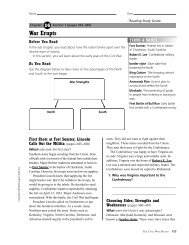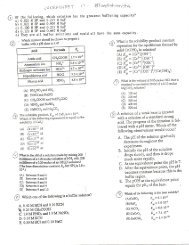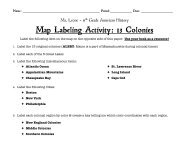Chapter 16 Text
Chapter 16 Text
Chapter 16 Text
You also want an ePaper? Increase the reach of your titles
YUMPU automatically turns print PDFs into web optimized ePapers that Google loves.
<strong>16</strong>.9 Acid-Base Properties of Salt Solutions 641<br />
(b)K& for NH3 is listed in Table <strong>16</strong>.4 and in Appendix D as Kh = 1.8 X 1CT5. Using<br />
Equation <strong>16</strong>.40, we can calculate Ka for the conjugate acid, NH4+:<br />
Kb 1.8 x 1(<br />
PRACTICE EXERCISE<br />
(a) Which of the following anions has the largest base-dissociation constant:<br />
/ PO43 / or N3~? (b) The base quinoline has the following structure:<br />
oio<br />
Its conjugate acid is listed in handbooks as having a pKa of 4.90. What is the base-dissociation<br />
constant for quinoline?<br />
Answers: (a) PO43~(K& - 2.4 x 1(T2}; (b) 7.9 X 10~10<br />
<strong>16</strong>.9 Acid-Base Properties of Salt Solutions<br />
Even before you began this chapter, you were undoubtedly aware of many substances<br />
that are acidic, such as HNO3, HC1, and H2SO4, and others that are basic,<br />
such as NaOH and NHs. However, our recent discussions have indicated that<br />
ions can also exhibit acidic or basic properties. For example, we calculated Ka<br />
for NH4+ and K^ for F~ in Sample Exercise <strong>16</strong>.<strong>16</strong>. Such behavior implies that salt<br />
solutions can be acidic or basic. Before proceeding with further discussions of<br />
acids and bases, let's examine the way dissolved salts can affect pH.<br />
We can assume that when salts dissolve in water, they are completely dissociated;<br />
nearly all salts are strong electrolytes. Consequently, the acid-base properties<br />
of salt solutions are due to the behavior of their constituent cations and<br />
anions. Many ions are able to react with water to generate H+(ag) or OHT(flq).<br />
This type of reaction is often called hydrolysis. The pH of an aqueous salt solution<br />
can be predicted qualitatively by considering the ions of which the salt is<br />
composed. \<br />
Bassam Z. Shakhashiri, "Hydrolysis:<br />
Acidic and Basic Properties of Salts,"<br />
Chemical Demonstrations: A<br />
Handbook for Teachers of Chemistry,<br />
Vol. 3 (The University of Wisconsin<br />
Press, Madison, 1989) pp. 1 03-108.<br />
An Anion's Ability to React with Water<br />
In general, an anion, X~, in solution can be considered the conjugate base of an<br />
acid. For example, Cl~ is the conjugate base of HC1 and C2H3O2^ is the conjugate<br />
base of HC2H3O2. Whether an anion reacts with water to produce hydroxide<br />
depends upon the strength of the acid to which it is conjugate. To identify the acid<br />
and assess its strength, we can simply add a proton to the anion's formula:<br />
X" plus a proton gives HX<br />
H the acid determined in this way is one of the strong acids listed at the beginning<br />
of Section <strong>16</strong>.5, then the anion in question will have a negligible tendency<br />
to abstract protons from water (Section <strong>16</strong>.2) and the following equilibrium will<br />
lie entirely to the left:<br />
H2O(0 [<strong>16</strong>.42]<br />
Consequently, the anion X will not affect the pH of the solution. The presence<br />
°f Cr in an aqueous solution, for example, does not result in the production of<br />
any OH" and does not affect the pH.<br />
/
















